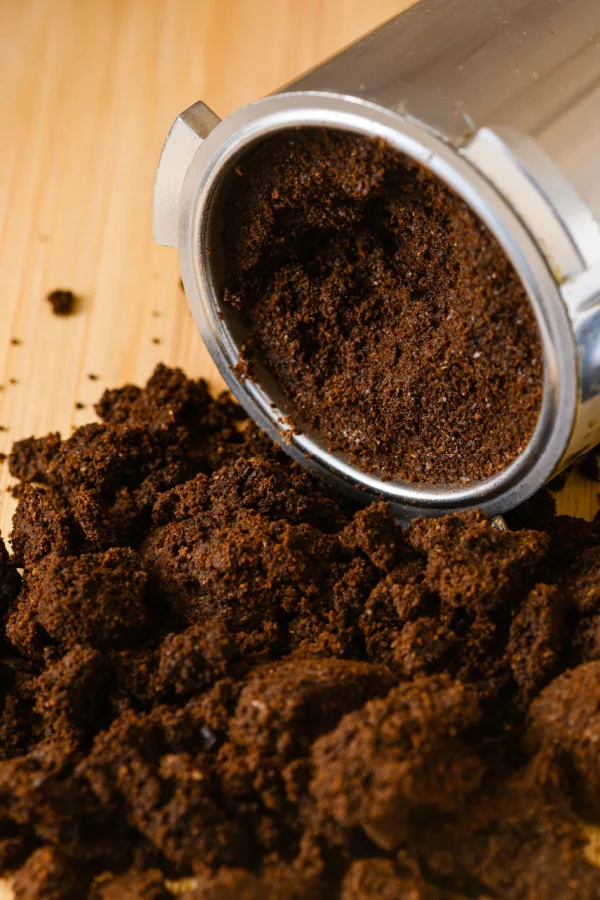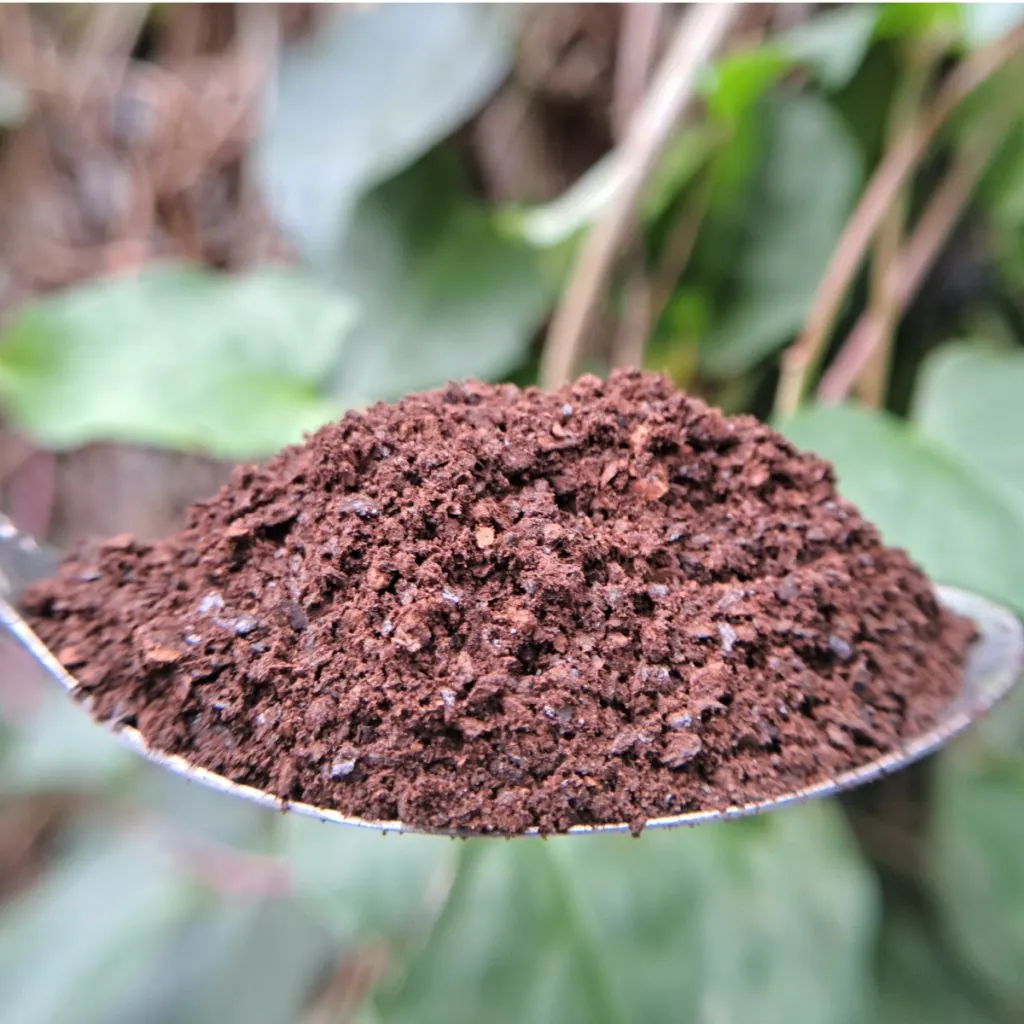Looking for a few easy ways to use up the coffee grounds coming from all of those warming cups of coffee this fall?
As the weather cools and fall mornings bring a chill to the air, many people find themselves reaching for an extra cup of coffee. But with more being brewed each day, that also means more spent coffee grounds piling up in kitchen!
Most of the time, the used grounds end up tossed into the trash without a second thought. However, gardeners and homeowners alike may be surprised to learn that coffee grounds can be an incredible resource. Especially in the fall when it comes to recharging tired, weak soil.

3 Easy Ways To Use Coffee Grounds This Fall
1. Restore Raised Bed Soil
One of the best ways of all to use coffee grounds in the fall is in your raised beds. A long summer of growing vegetables, herbs, and flowers can leave raised bed soil completely worn out. Plants use up a lot of nutrients to fuel their growth. But adding spent coffee grounds is an easy and effective way to breathe life back into raised beds.
Coffee grounds add small amounts of nitrogen and other minerals while also improving soil texture. Their organic matter loosens compacted soil and allows better air flow and drainage, all while helping the soil retain just the right amount of moisture.
To use, in the fall, sprinkle two to three cups of grounds for every square foot of soil. Work them gently into the top few inches of dirt. If you still have paper coffee filters, bury those along with the grounds. They will decompose and add even more organic material.
2. Supercharge Your Compost Piles With Coffee Grounds This Fall
Another great way to use coffee grounds in the fall is to help heat up your compost pile. Composting is one of the best ways to recycle organic waste from the garden and kitchen, and coffee grounds can play a major role in creating rich, fertile compost.

Every compost pile needs a good mix of “brown” and “green” materials. Browns, like dried leaves, straw, or shredded cardboard, provide carbon. Greens, like vegetable scraps, grass clippings, and coffee grounds, provide nitrogen.
Nitrogen is essential because it helps raise the internal temperature of the pile, speeding up decomposition. Without enough greens, compost piles often break down slowly and unevenly. But adding coffee grounds is a simple solution to this problem.
The grounds provide the needed nitrogen boost while also attracting helpful worms and microorganisms that further aid in breaking everything down.
To use, sprinkle your daily grounds into the compost bin or pile and turn into the pile. Again, put the filter in too. Continue this pattern throughout the season, being sure to turn or mix the pile once or twice a week to keep oxygen flowing.
In fall, with an abundance of fallen leaves available, coffee grounds are the perfect partner to balance out all of that carbon. By spring, you’ll have dark, crumbly compost ready to add back into your garden beds.

3. Feed & Improve Your Lawn
Lawns are another place where spent coffee grounds can make a difference. Grass requires nitrogen, phosphorus, and potassium to stay green and lush. While synthetic fertilizers can provide these, they often contain chemicals that can be harsh on the environment.
Coffee grounds offer a natural, chemical-free way to add organic matter and nutrients back into your soil. And all for free!
To apply, spread a thin layer of grounds evenly over the lawn. Use a rake to work the grounds into the surface so they don’t clump together. Over time, the grounds will break down and release nutrients into the soil, just like a slow-release fertilizer.
Beyond nutrients, coffee grounds also help improve the structure of the soil beneath the grass. They add organic matter that helps loosen compacted soil, increase drainage, and retain water. This is especially useful in the fall, when lawns are recovering from summer stress and preparing for the colder months ahead.
Additional Benefits
Coffee grounds offer even more hidden advantages when used in gardens, flowerbeds and lawns. When added to soil or compost, they encourage earthworm activity, which naturally aerates and enriches the soil. Grounds also help soils hold moisture, which can be especially helpful in the spring when young seedlings are vulnerable to drying out.

Because they are rich in organic matter, coffee grounds continue to break down slowly over time, improving soil long after they’ve been applied. They can be combined with mulch, added to planting holes, or even mixed with potting soil for container gardens.
No matter how you choose to use them, spent coffee grounds are one of the easiest and most effective ways to recycle waste into something useful for the home and garden. But it’s important to make sure you only use spent grounds.
Why To Only Use Spent Coffee Grounds
Fresh coffee grounds, straight from the bag or can, are far too acidic for most plants and soils. That extra acidity can upset soil balance and even damage delicate roots if added directly.
On the other hand, once coffee has been brewed, the majority of that acidity is washed away with the liquid. What remains is a gentler material filled with trace nutrients and organic matter that can safely be added to the garden.

Another reason to only use spent grounds is cost. Fresh coffee grounds are simply too valuable to waste when they could be enjoyed in your mug instead.
If you don’t drink coffee yourself, don’t worry. Family, friends, and neighbors are often happy to share their leftovers, especially if they aren’t already reusing them. Many coffee shops and restaurants will also bag up grounds for gardeners who ask.
Some larger chains even keep containers near their counters where customers can take used grounds home for free. Collecting them this way gives you plenty of material to use in the fall season.
Here is to using coffee grounds this fall to rejuvenate your gardens, flowerbeds and lawn. And don’t forget, you can use them to power houseplants all winter too! See: How To Use Coffee Grounds & Coffee To Fertilize Houseplants.
Simple Garden Life
Follow Our Facebook Page For Even More Great Tips! Simple Garden Life Facebook Page
Simple Garden Life is a website dedicated to keeping gardening fun, simple and enjoyable! We publish two new articles each week along with a new garden podcast episode every two weeks. This article may contain affiliate links.
